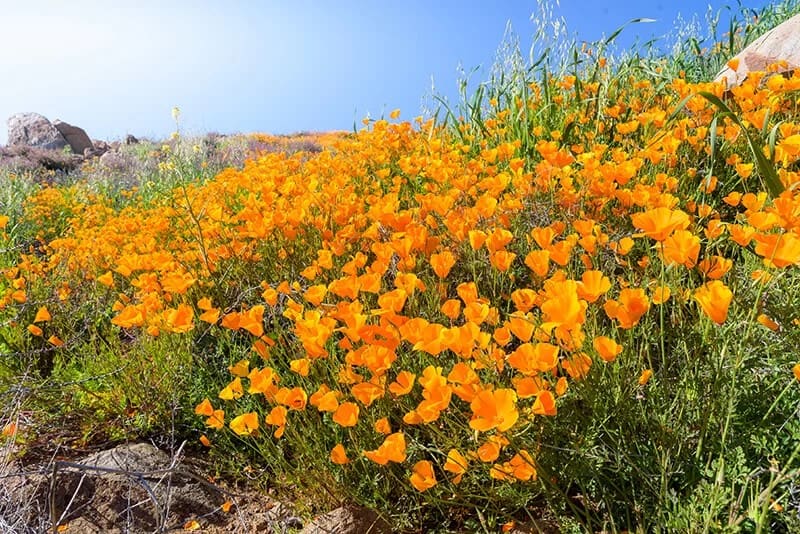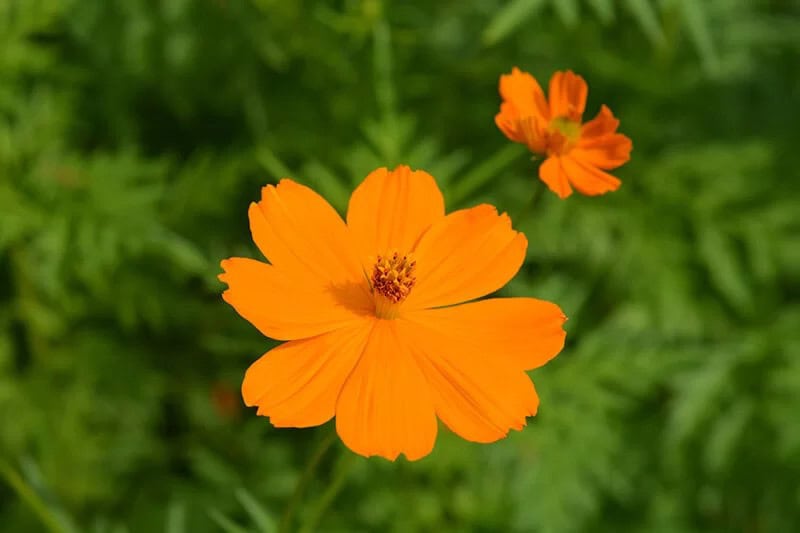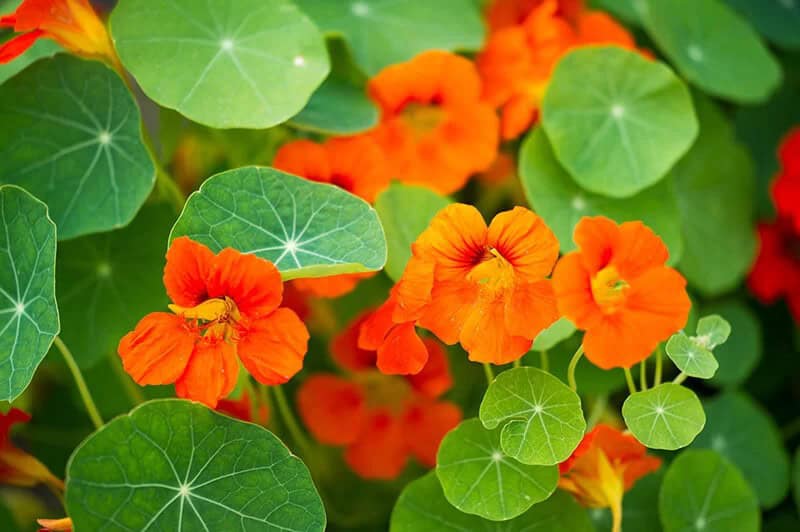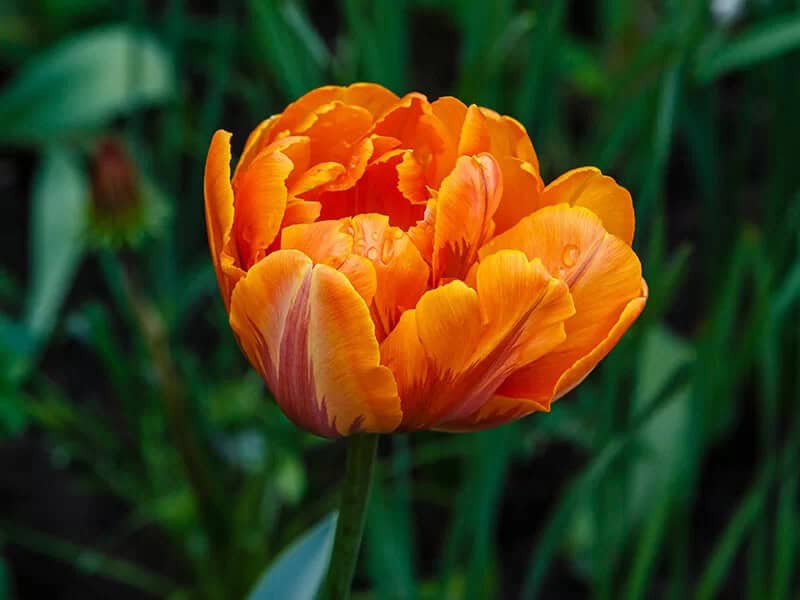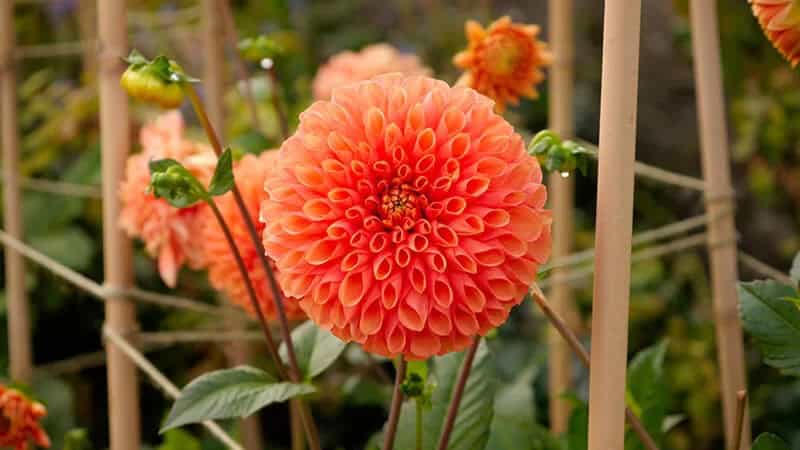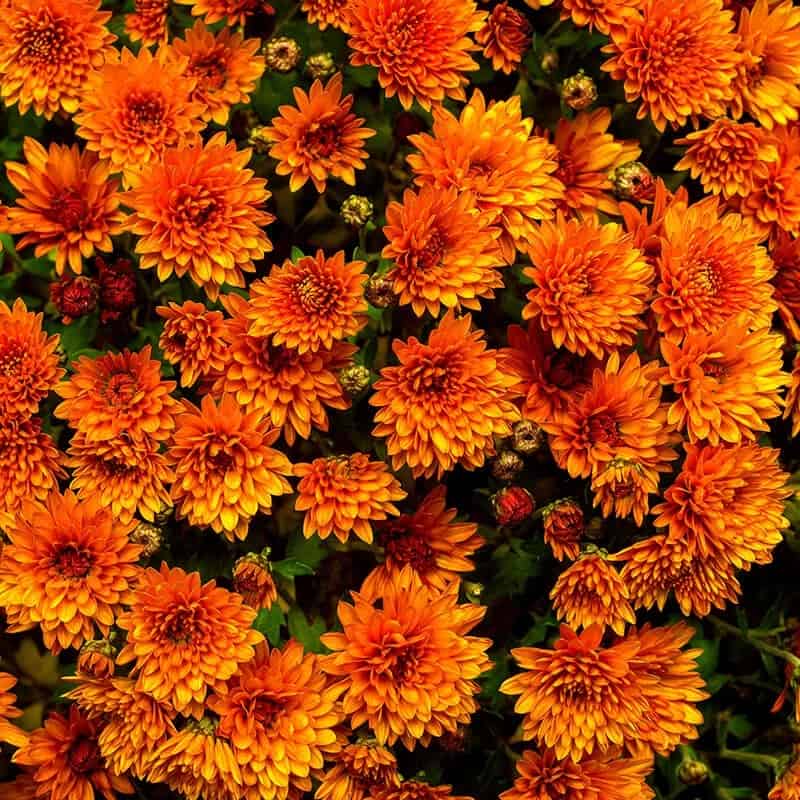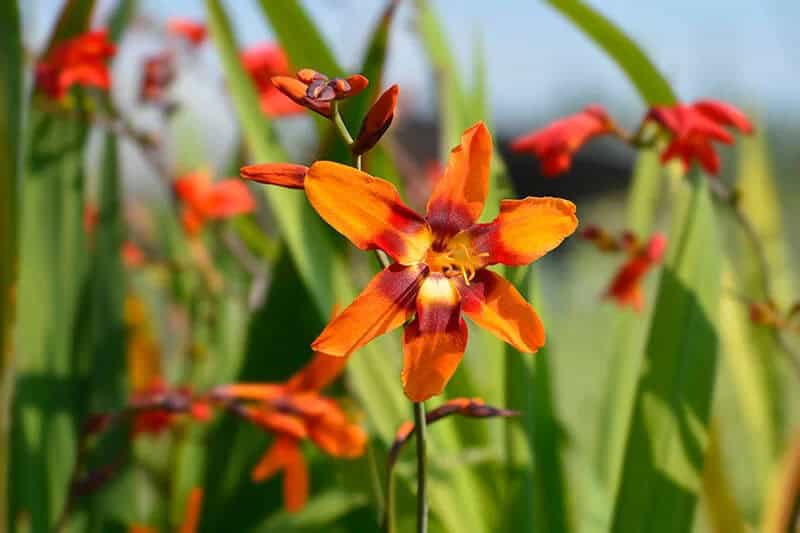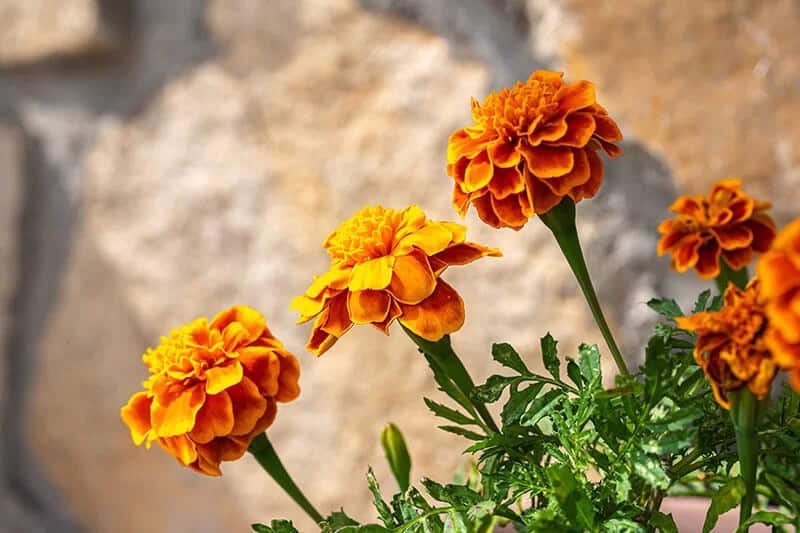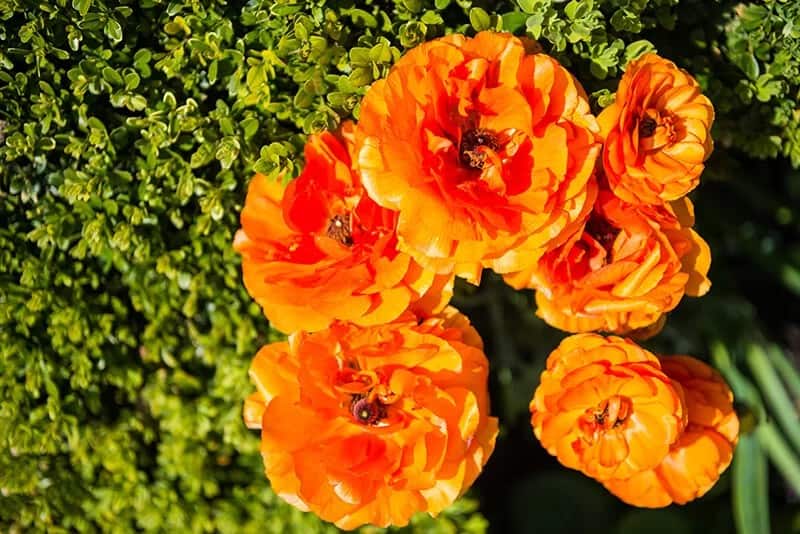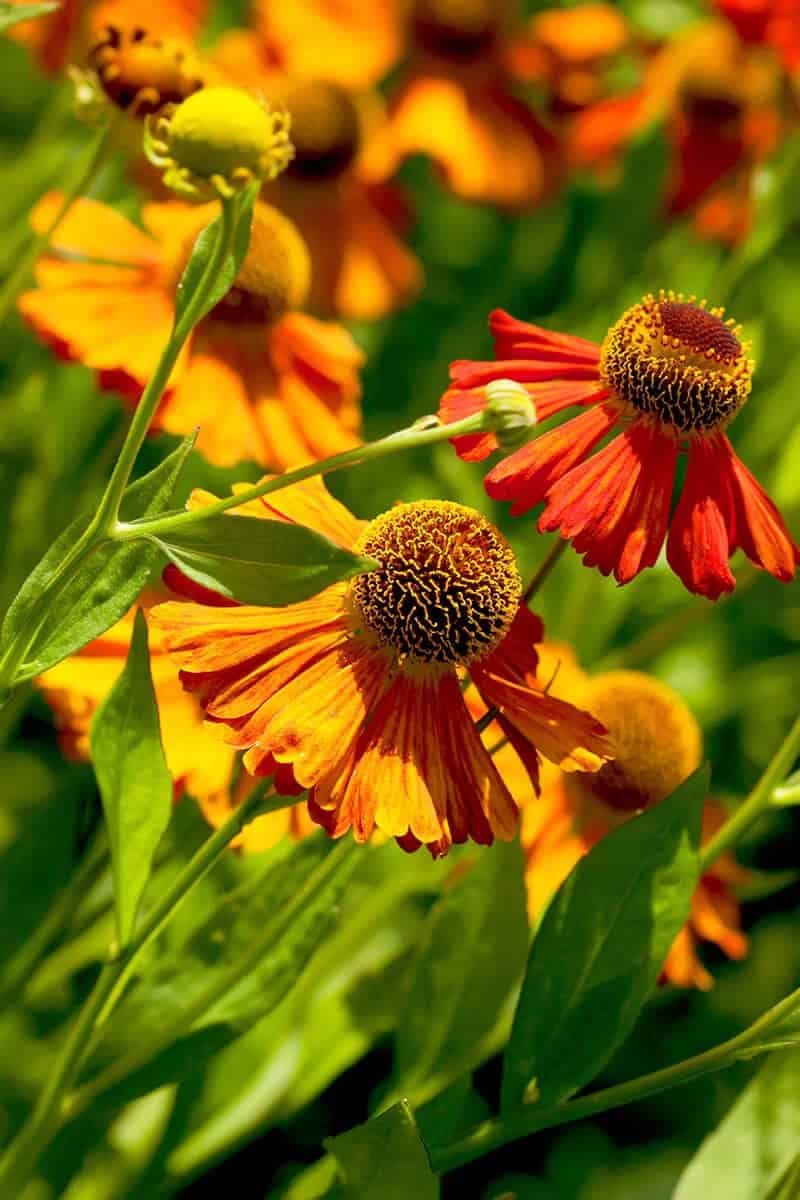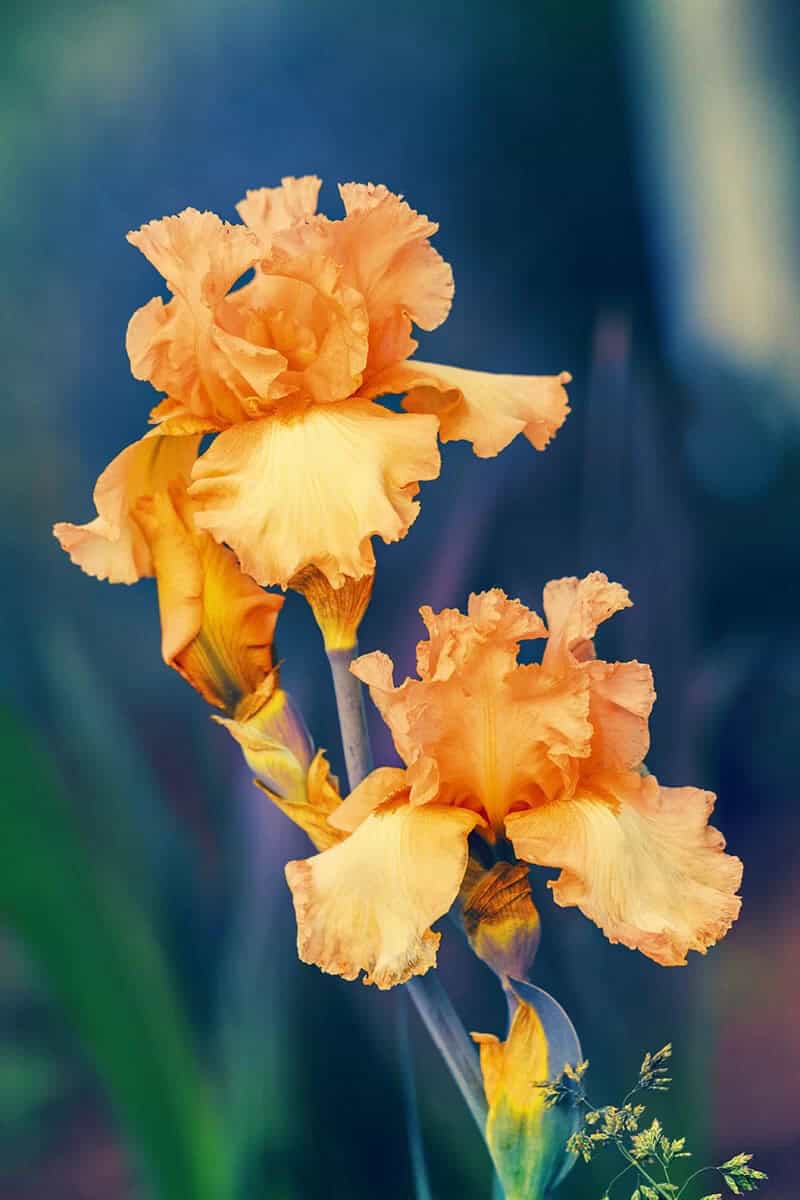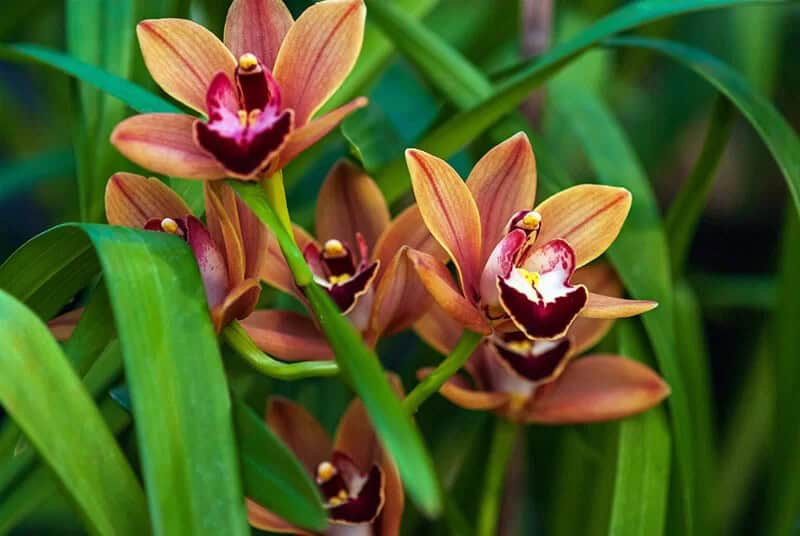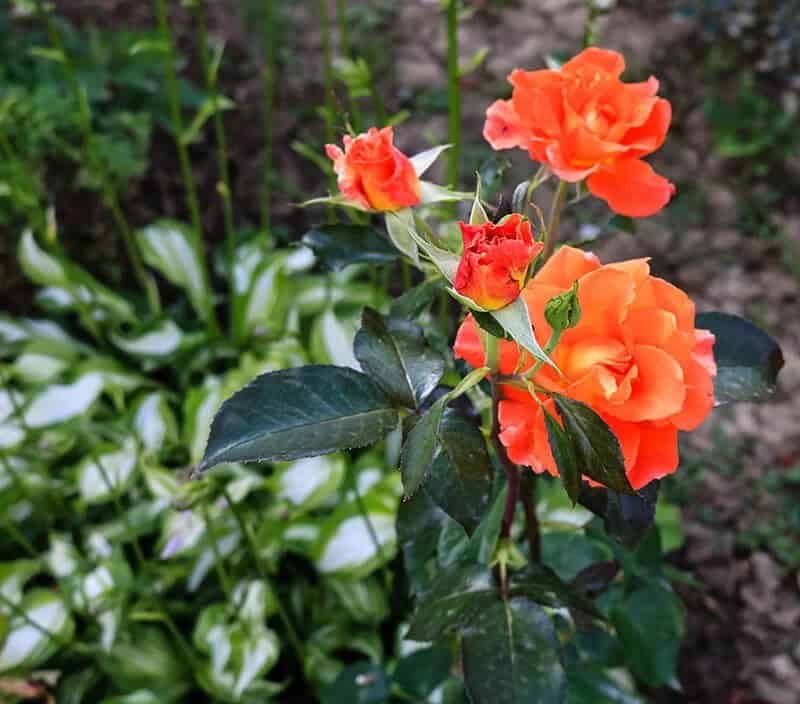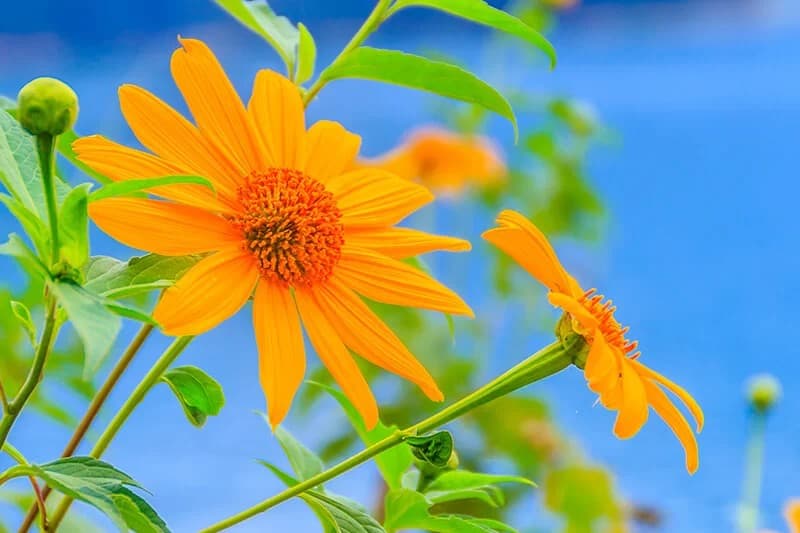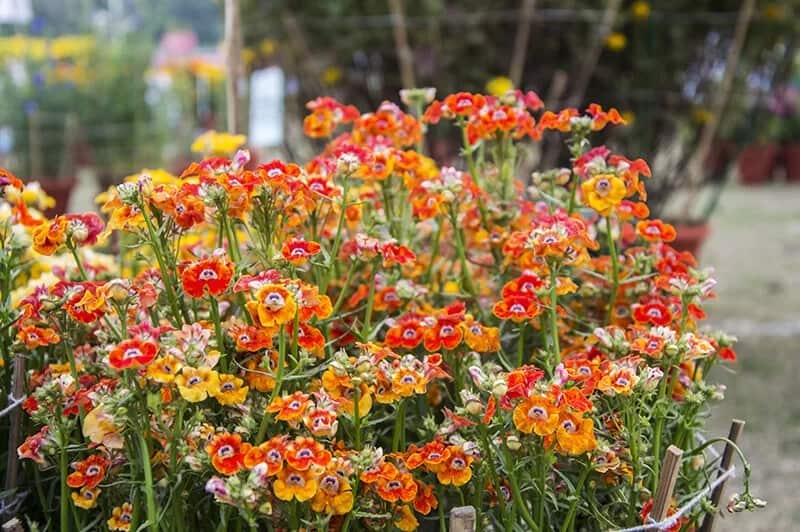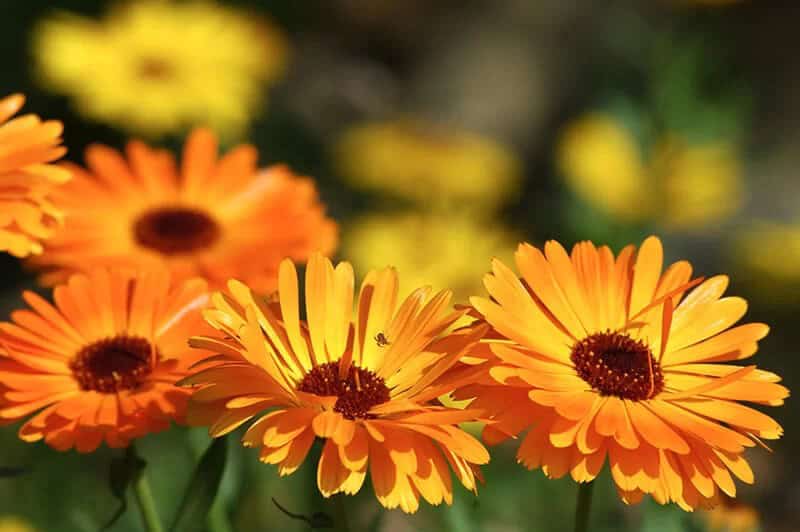Orange, the vibrant hue that commands attention, is an ideal choice for adding a pop of color to your garden. By incorporating orange flowers into your landscape design, you can effortlessly create a visually striking display that draws the eye without departing from nature’s palette. Annuals such as calendulas, nasturtiums, and marigolds are excellent options for achieving this effect, as they bloom in an array of warm, inviting shades of orange.
27 Majestic Orange Flowers for All Your Home Gardening Needs
When seeking to inject some vibrancy into your outdoor space, consider incorporating orange cosmos or tangerine dahlias. These showstoppers can be used to create a dramatic display by planting them en masse, or subtly scattered throughout the garden for a more understated look. Whatever approach you take, the stunning beauty of these orange flowers is sure to delight and add an exciting dimension to your outdoor oasis.
Orange Marigold (Tagetes Erecta)
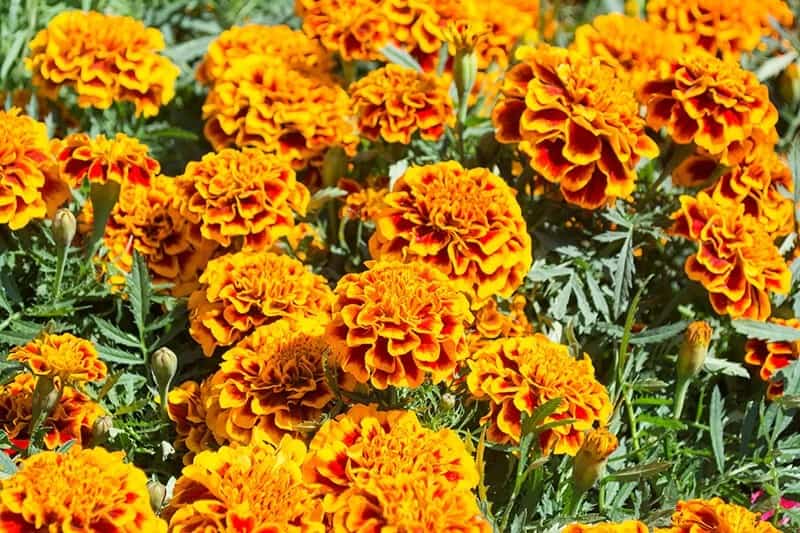
The annual marigold is a summertime staple that brings vibrant color to any garden. Its symbolism is rooted in the sun, creativity, and joy, making it an excellent choice for brightening up a space. To keep these blooms thriving, you’ll want to provide medium to weekly watering, as they prefer well-drained soil with a neutral pH (slightly acidic to alkaline).
Marigolds are hardy annuals that can be grown in every zone and will flourish when planted in full sun, receiving the perfect amount of light. Their blooming season typically spans from summer until frost, making them an excellent choice for adding color to your garden during this time. Additionally, these flowers come in shades of orange, yellow, and red, offering a range of options for creating a unique and eye-catching display.
To keep your marigolds looking their best, be sure to deadhead spent flowers and plant them in well-draining soil with plenty of direct sunlight.
California Poppy (Eschscholzia Californica)
The iconic poppy, California’s official state flower, is a symbol of the Golden State’s laid-back and sunny disposition. With its low water requirements – simply water when the soil feels dry to the touch – this cheerful bloom thrives in well-drained, sandy soil and basks in full sun. As an annual in all hardiness zones 4 to 8, you can enjoy its vibrant blooms from late spring to early summer with minimal upkeep.
Orange Cosmos (Cosmos Sulphureus)
The Orange Cosmos, with its distinctive shape, has become a popular choice for bouquets and floral arrangements due to its vibrant orange hue. This annual flower thrives in well-drained soils, such as sand, loam, or clay, and requires medium watering, allowing the soil to dry out slightly between hydration. In warm climates, it blooms from summer to fall. As an easy-to-maintain plant, the Orange Cosmos is perfect for adding a pop of color to your landscape.
Simply sow its seeds in full sun to part shade and enjoy the beauty it brings.
Nasturtium (Scientific Name: Tropaeolum Majus)
Nestled in full sun to part shade, nasturtiums burst forth with vibrant orange blooms that not only tantalize the senses but also pay homage to patriotism. These hardy flowers thrive in well-drained soil and can be grown in every hardiness zone. As a bonus, they’ll provide a pop of color throughout the summer until frost sets in, making them an excellent choice for elevating your garden’s visual appeal. Plus, their edible flowers allow you to get creative with salads and other culinary delights.
Orange Pansy (Viola x Wittrockiana)
The vibrant orange blooms of this pansy variety are sure to bring joy and optimism to any outdoor space. As it’s one of the longest-blooming pansies around, you can expect a kaleidoscope of color from spring to fall. For optimal growing conditions, provide consistently moist but well-drained soil and full sun. Medium watering is sufficient, as long as the soil doesn’t dry out completely.
This hardy flower thrives in all zones, making it a great addition to containers, hanging baskets, or garden beds.
Orange Tulip (Tulipa ‘Orange Princess’)
Orange tulips bring a burst of passion, energy, and excitement to any garden with their vibrant blooms. To thrive, these flowers require medium watering – the soil should be kept moist but not soggy. A well-drained sandy loam is also preferred for optimal growth. As they are adaptable to various climates, orange tulips can grow in all hardiness zones throughout the United States, excluding Alaska and Hawaii. For the best results, provide them with full sun to partial shade.
Typically, these flowers bloom from April to May, although they sometimes continue into early summer.
Painted Abutilon (Abutilon Pictum ‘Thompsonii’)
A vibrant and charismatic addition to any garden, painted abutilon is a true showstopper. Its striking orange-red blooms stand out against its deep green leaves, creating a stunning visual display. As an annual plant, it has a limited lifespan of just one season, but during that time, it will provide a never-ending supply of colorful flowers from late spring until the first frost.
With medium watering needs and a preference for rich, well-drained soil, painted abutilon is relatively easy to care for. It thrives in part sun or shade and can be grown in any hardiness zone, making it an excellent choice for gardeners of all experience levels.
Orange Lily (Lilium Bulbiferum)
These perennial early bloomers are ideal for adding a pop of color and drama to your summer or spring garden. With their large, orbicular orange flowers blooming abundantly from May to July, they create a stunning display that’s hard to ignore. One of the unique features of Lilium bulbiferum is its upward-facing flowers, which attract insects for pollination unlike many other Lily species that have pendant blossoms to protect their pollen supplies.
To thrive, these flowers require well-draining loamy soil rich in humus, medium watering (about one inch per week if the soil feels dry), and dappled sun or light summer shade. They’re hardy in zones 8-10, making them a great choice for gardeners in those regions.
Dahlia (Dahlia Pinnata)
Dahlias are a symbol of wealth, elegance, love, and involvement, making them a unique choice for expressing one’s emotions. These late-blooming flowers thrive in moderate watering conditions, requiring about an inch of water per week when the soil feels dry to the touch.
When it comes to soil quality, dahlias prefer moist but well-draining loamy soil with a pH range of 5.0-7.0.
They also require partial to full sun, making them ideal for gardens that receive direct sunlight for at least 6 to 8 hours daily.
It’s worth noting that dahlias are sensitive to strong winds and can be blown over if not properly supported. To achieve great results, plant these tubers in a location with gentle breezes and enjoy the stunning blooms from midsummer through fall.
Birds of Paradise (Strelitzia Reginae)
The sacred lotus (Nelumbo nucifera) is a stunning aquatic plant that holds immense symbolic significance. It represents faithfulness, love, and thoughtfulness, making it a revered element in many cultures. In terms of its growing requirements, the sacred lotus thrives in moderate water conditions, preferring loamy, moist, and well-drained soils with a pH range of 6-6.5.
This beautiful plant is hardy enough to flourish in zones 10 to 12, but it’s also sensitive to light, requiring full sun exposure to reach its full potential. The sacred lotus typically blooms late winter to early spring, making it a breathtaking sight to behold during this time.
Chrysanthemum (Scientific Name: Chrysanthemum Morifolium)
Chrysanthemums, also known as garden mums, boast a unique, spiral-like bloom pattern that unfurls in late summer or early fall, persisting until the first frost. This charming floral display is accompanied by a delicate love symbolism, making them a popular choice for sentimental arrangements. When it comes to growing conditions, chrysanthemums require medium water levels and thrive in well-drained soils with a pH of 6.5.
They are hardy in zones 3 to 9, making them suitable for gardeners across a wide geographic range. In terms of light requirements, these flowers demand full sun exposure to reach their full potential. As the seasons transition into late summer and early winter, chrysanthemums burst forth with vibrant blooms, providing a natural insect repellent that effectively drives away mosquitoes, bugs, and other pests.
Two popular orange cultivars, Miranda and Dixter, are particularly prized for their effectiveness in repelling unwanted insects.
Coppertips (Scientific Name: Crocosmia)
In the realm of symbolism, this flower is often associated with deep emotions and feelings of love, as well as confidence. Its beauty is not only a visual treat but also holds profound meaning. When it comes to its care, the flower requires moderate watering, making sure the soil feels dry between each hydration session. A moist, drained soil with a neutral pH provides the ideal environment for growth.
In terms of hardiness, this flower thrives in zones 6 to 9, allowing gardeners in these regions to cultivate it with ease. As for light, while full sun is preferred, partial sun can be tolerated, making it suitable for a variety of settings. Finally, the blooming season typically falls between mid-summer and mid-fall, offering a delightful display of color during this time.
Carnation (Scientific Name: Dianthus Caryophyllus)
Carnations, with their delicate petals and sweet aroma, evoke feelings of happiness and warmth. As a popular cut flower, they’re often used to express joy and appreciation, particularly when it comes to motherly love. In terms of growing conditions, carnations require moderate watering, thriving in average to moist soil with a pH of 6.7. They can tolerate a range of hardiness zones from 3 to 9, making them suitable for most regions.
When it comes to sunlight, carnations need full sun to bloom beautifully, with their ruffled petals on display. As late-spring bloomers, they typically flower for up to eight weeks, offering a prolonged period of color and fragrance. With their vibrant colors ranging from purple to orange, white to pink, red to yellow, carnations are an excellent choice as a thoughtful gift for your mom.
Begonia (Scientific Name: Begonia Obliqua)
Incorporating the symbolic significance of begonias, these annuals embody uniqueness, harmony, gratitude, and peace. To bring out their best features, they require specific conditions. For instance, a consistent watering schedule is crucial to keep them thriving. In terms of soil, begonias need rich, moist, and well-draining soil with a pH range of 5.5-6.2. Their hardiness zones are relatively narrow, ranging from 9 to 11. As for light, they prefer full sun or partial shade.
The blooming season typically spans early summer until frost. Begonias’ unique waxy green foliage and vibrant flowers in shades like vivid orange make them a standout. However, they do have one vulnerability: rot and mildew can set in if the humidity is too high. To prevent this, it’s essential to space them correctly during planting, allowing for adequate air circulation and minimizing the risk of rotting.
Buttercup (Scientific Name: Ranunculus Asiaticus)
Buttercups are a sight to behold, with their delicate rose-shaped blossoms bursting forth in a kaleidoscope of colors – think yellow, white, red, pink, or orange. The petals have a silky texture, adding an extra layer of charm to these already captivating flowers. In terms of growth requirements, buttercups do best in sandy or loamy soil with good drainage and a slightly acidic pH. Regular watering is also key, as the plants thrive when the soil is dry.
Buttercups are hardy in zones 8 to 11, making them a great choice for gardeners in those regions. They enjoy full sun, so make sure to plant them in an area that gets plenty of direct sunlight. As for blooming season, buttercups typically produce their beautiful flowers in the early-mid summer and spring months, with some varieties like Elegance Orange producing copious blooms for around six weeks if properly planted and cared for.
Lantana (Scientific Name: Lantana Camara)
Lantana, a native flower of the tropical Americas, specifically South and Central America, is known for its distinctive aroma that draws in pollinators. This fragrant bloom produces pom-pom-shaped clusters of tiny, tube-like flowers with four petals each. A notable characteristic is the plant’s poisonous berries, which transform from green to dark purple as they mature.
With a moderate water requirement, average soil moisture and full sun exposure, Lantana thrives in hardiness zones 7 to 11, typically blooming from midsummer until frost.
Gerbera Daisy (Scientific Name: Gerbera Jamesonii)
The symbolically charged Gerbera daisy, with its cheerful and innocent connotations, is often overlooked despite being the fifth most popular flower worldwide. The secret to its enduring appeal lies in its unique appearance – a sunflower-like center gives it an uncanny resemblance to true daisies. With their compact growth habit, these flowers are ideal for adding a pop of color to vases or garden displays.
One notable cultivar, Garvinea Orangina, boasts bright orange blooms that radiate joy and purity, making them a delightful addition to any floral arrangement. Gerbera daisies require moderate watering, well-drained soils with a pH between 6-7, and full sun to thrive in USDA hardiness zones 9-11. Their blooming period spans from early spring through autumn, providing a prolonged period of vibrant color and beauty.
Lion’s Tail (Scientific Name: Leonotis Leonurus)
The vibrant, two-lipped flower of the tubular fuzzy orange plant stands out with its regal, creative, and colorful symbolism. This striking bloom thrives in well-drained soils with a neutral pH of 6.6, making it an ideal addition to gardens in USDA zones 8-11. With low water needs and the ability to withstand drought, this perennial is perfect for mild climates or can be grown as an annual in colder temperatures.
Its tiered whorls around the top half of long upright stems create a unique display, adding an exotic touch to your garden from late summer to fall. Whether you’re looking for a statement piece or simply want to bring some excitement to your outdoor space, this fuzzy orange flower is sure to impress.
Helenium (Scientific Name: Helenium Autumnale)
The Sneezeweed (also known as Helenium) is a captivating perennial that thrives in gardens during late summer. Its daisy-like flowers radiate vibrant colors, drawing bees and other pollinators to its charming blooms. What’s more, these flowers have an extended blossoming period when rejuvenated annually.
Not only are they attractive to beneficial insects, but their bright orange hues also make them a popular choice for cut flower arrangements, allowing you to capture stunning images of their radiant beauty. To grow this delightful perennial, you’ll want to provide it with moderate watering, fertile and well-drained soils, and full sun exposure. Its ideal growing zones are 3 to 8, making it a great option for many gardeners.
Iris (Scientific Name: Iris Croatica)
The majestic iris, also known as maiden orange, boasts a striking array of orange flowers that bring a pop of color to your garden during late spring and early summer. This award-winning plant is renowned for its rapid growth rate and prolific blooming. One of the most notable advantages of growing irises is their impressive drought resistance capabilities, allowing them to thrive in a variety of soil types and environments. With moderate watering needs, well-drained soils with a pH range of 6.
8-7, and full sun or partial shade, irises are suitable for growing zones 3 to 9. Their blooming season typically occurs from March to June, making them an excellent addition to any garden seeking a splash of vibrant color and low-maintenance beauty.
Butterfly Weed (Asclepias Tuberosa)
The symbolism behind the Orange Milkweed (Asclepias tuberosa) is deeply rooted in dignity, remembrance, and freedom. This stunning flower boasts a low water requirement, making it an ideal choice for gardeners who prioritize conservation. In terms of soil, Orange Milkweed thrives in dry to average soil moisture with excellent drainage and a slightly acidic pH between 6-7. Its hardiness is impressive, as it can be grown in zones 4 to 9.
When it comes to light exposure, the Orange Milkweed prefers full sun to partial shade, allowing it to bask in the warm glow of the sun while still providing some shelter from intense heat. The blooming season typically occurs late spring, a time when nature awakens and beauty abounds.
Also known as Chigger flower or Butterfly Milkweed, this enchanting orange flower plant is characterized by clusters of tiny blooms that burst forth in vibrant orange hues, attracting butterflies and other pollinators to your garden. Its laid-back demeanor makes it an excellent choice for borders, where its delicate beauty can be fully appreciated.
Cymbidium Orchid (Scientific Name: Cymbidium)
Cymbidium orchids, also known as boat orchids, boast a unique symbolism – pure, valued, and respected friendship. To cultivate these stunning flowers, you’ll need to provide the right conditions. Water them frequently, about twice per week, to keep their roots happy. The soil should be loamy, moist, and well-drained, with a pH level of 5.5-6.5. If you’re looking for a low-maintenance option, Cymbidiums are an excellent choice for beginners.
They thrive in zones 10 to 12 and can tolerate partial shade. As they bloom from mid-autumn to mid-spring, they’ll provide a beautiful winter-to-spring display that’s both cool and fresh. With their ability to adapt to different climates and ease of growth, it’s no wonder why Cymbidiums are a popular choice among orchid enthusiasts.
Rose (Scientific Name: Rosa)
A symbol of energy and enthusiasm, orange roses boast vibrant colors that bloom throughout the season. Requiring medium water levels and thriving in well-drained soils with a pH range of 5.5-7, these roses are perfect for zones 4 to 9. As full-sun lovers, they need direct sunlight to flourish. Additionally, their blooming period spans mid-spring to fall, making them a popular choice among florists despite their relatively poor fragrance.
The striking orange hue of these modern roses makes them an eye-catching addition to any garden or arrangement.
Mexican Sunflower (Scientific Name: Tithonia Diversifolia)
The Black-Eyed Susan (Helianthus annuus) boasts a unique charm, symbolizing loyalty and adoration. As an annual plant, it thrives in conditions that are low on water needs, making it a great option for drought-prone areas. Its soil requirements include well-draining properties with a slightly alkaline pH range of 6.6 to 7.5. The ideal growing zones for this sun-loving beauty lie between 9 and 11. While full sun is its preference, it can also tolerate partial shade.
Throughout the summer until frost, it produces stunning blooms featuring large, black-centered flowers with bright orange petals that attract butterflies and offer a photographer’s delight. It’s essential to deadhead spent blooms to encourage repeat flowering and promote healthy growth. An added bonus lies in using the deadheaded plants as nutritious fodder for rabbits and ruminants.
Crown Imperial (Scientific Name: Fritillaria Imperialis)
The majestic crown-shaped tulip boasts a striking feature – its downward-facing appearance. This unique characteristic is accompanied by intricate veining and white dot markings within the petals. As the plant’s beauty extends beyond its aesthetic appeal, it also requires specific growing conditions to thrive. The cool-season bulb thrives in well-drained soils with a pH range of 5-8.5, making zones 4 to 10 suitable for cultivation.
In terms of light and water requirements, tulips prefer full sun to partial shade and low moisture levels, respectively. When it comes to blooming season, these spring bulbs typically come into their own in the spring, providing a vibrant display of color.
Nemesia (Scientific Name: Serengeti Sunset)
Incorporating the vibrant orange hue of Nemesias into your garden design can be a fantastic way to add visual interest and functionality. This versatile plant is well-suited for various applications, including serving as a ground cover, edging plant, or adding height and color to hanging baskets or container gardens. Its unique appearance also makes it an excellent choice for mixed borders.
One of the defining characteristics of Nemesias is its striking resemblance to both lobelias and orchid plants. The leaves are shaped like lances and grow in pairs along the stems, while the flowers boast a distinctive two-lipped tubular shape. To thrive, Nemesias require regular watering, well-drained soils with a pH between 6-7, and full sun to partial shade. They also prefer warmer climates, growing best in zones 9-11 during the blooming season of April to June.
Calendulas (Scientific Name: Calendula Officinalis)
The calendula flower, with its vibrant orange hue, is a popular choice among garden enthusiasts. This lovely bloom is steeped in symbolism, conveying emotions of grief, sympathy, and comfort. Its medium water requirements make it an accessible addition to any garden. Calendulas thrive in well-drained, sandy soil and can be grown as annuals in all zones. They also require full sun to part shade, making them a versatile option for gardens with varying light conditions.
As the summer and fall seasons unfold, these flowers burst into bloom, adding a pop of color and vibrancy to any landscape. With their ease of care and numerous meanings, calendula flowers are an excellent choice for those seeking a low-maintenance yet impactful addition to their outdoor space.
27 of the Most Beautiful Orange Flowers You Can Plant
When it comes to injecting a burst of cheer into your garden, few options compare to the humble orange flower plant. Whether planted solo or paired with other blooms, these vibrant flowers are sure to bring a smile to your face. Their large, showy blossoms and diverse fragrances make them a magnet for pollinators, while their bright hue adds a pop of color to the landscape without straying too far from nature’s palette.
The different types of orange plants bloom at various times of year, with some varieties thriving as annuals and others as perennials, depending on factors like climate, water, light, and soil conditions. If you’re looking to add some excitement to your garden, planting orange flowers is an excellent way to do so, resulting in a vibrant and visually appealing space that’s sure to attract attention.
